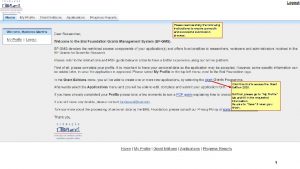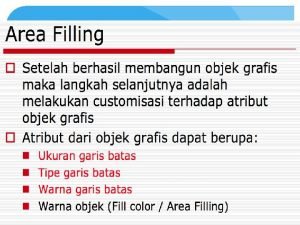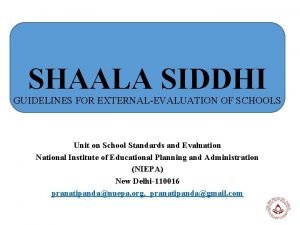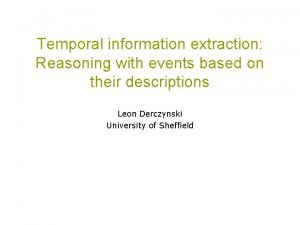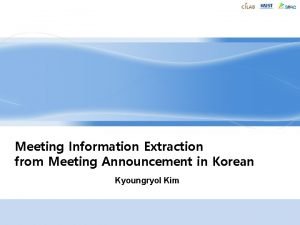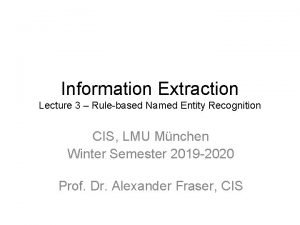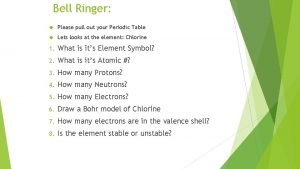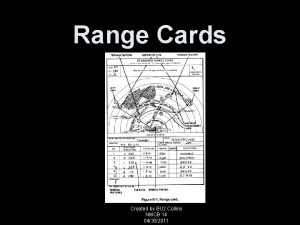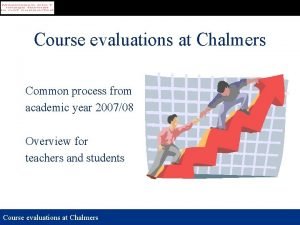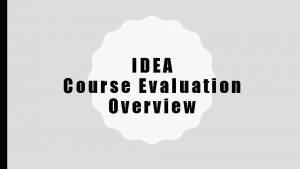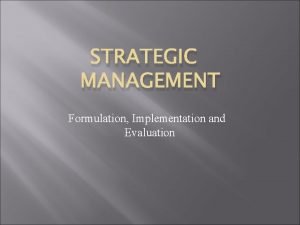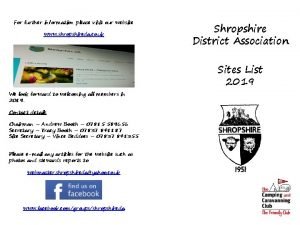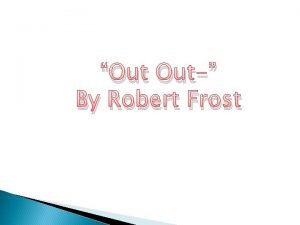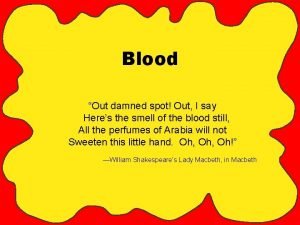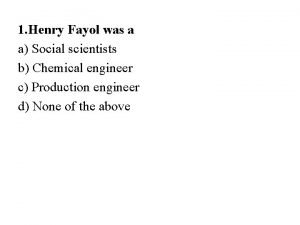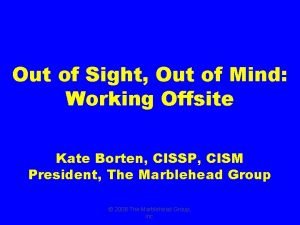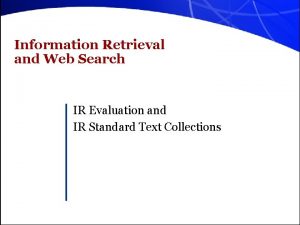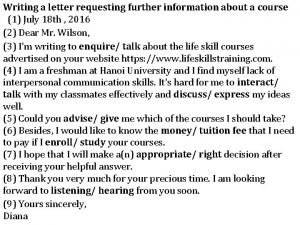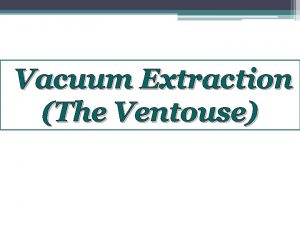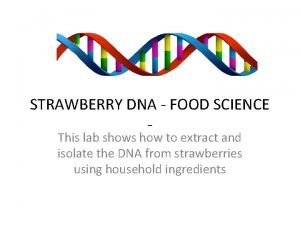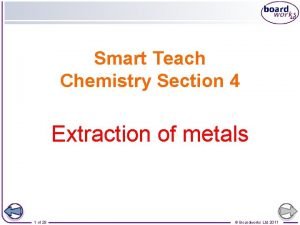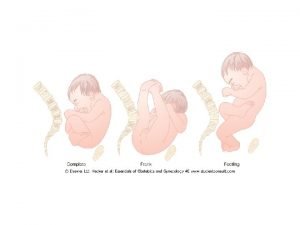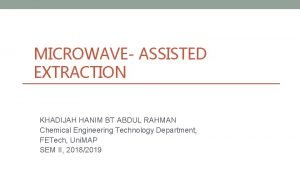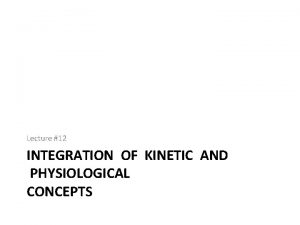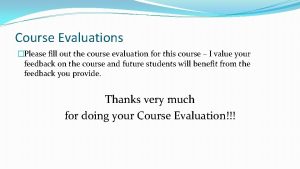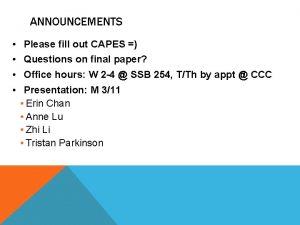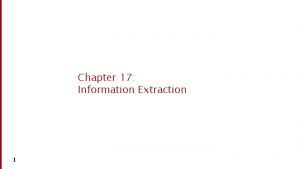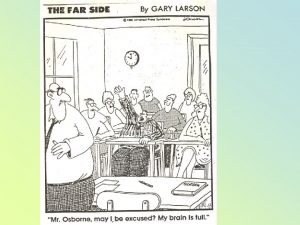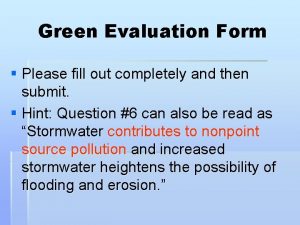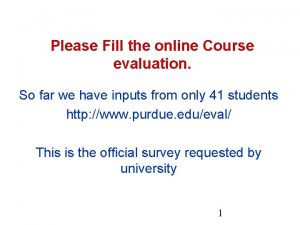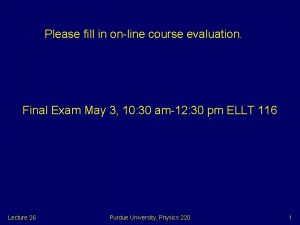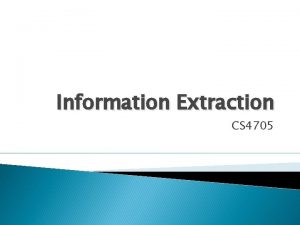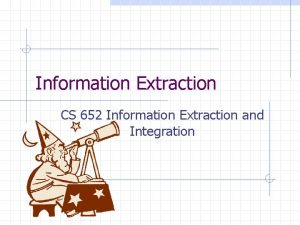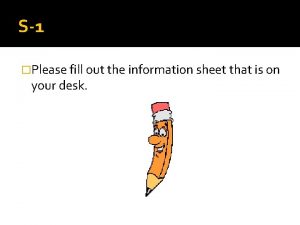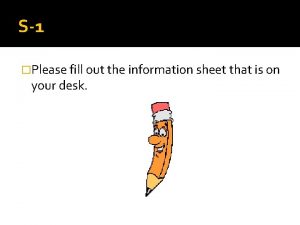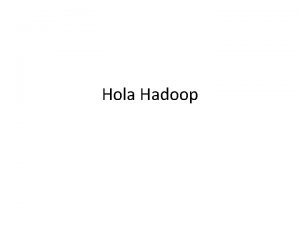Information Extraction Announcements Course evaluation please fill out





















![Pattern Matching for Relation Detection • Patterns: • “[CAR_TYPE] went out of control on Pattern Matching for Relation Detection • Patterns: • “[CAR_TYPE] went out of control on](https://slidetodoc.com/presentation_image_h2/564a7e068f07c569762b527ecf0d62a9/image-22.jpg)




![Task: Produce a biography of [person] 1. Name(s), aliases: 2. *Date of Birth or Task: Produce a biography of [person] 1. Name(s), aliases: 2. *Date of Birth or](https://slidetodoc.com/presentation_image_h2/564a7e068f07c569762b527ecf0d62a9/image-27.jpg)






































- Slides: 65

Information Extraction

Announcements • Course evaluation: please fill out • HW 4 extended to noon, 12/4 • Thursday: bring your laptop! • Poetry generation • Final review • Final exam: 12/21, final is cumulative • What topics would you like to hear about again? • Dan Jurafsky’s talk: 5 pm today, CEPSR auditorium. Hope to see you all there! “Does this Vehicle Belong to You? ”

Enabling Connections in a Hyperconnected World through Emotion AI Taniya Mishra, Affectiva • Date: Wednesday, December 6 th • Time: 7 -8 pm • Location: Room 504 of the Diana Center • Abstract: • We live in a hyperconnected world powered by smart devices. A big part of building connections is recognizing and responding to emotions. But our smart devices still lack this fundamental aspect of social communication, rendering our interactions with or through them superficial and limited. Now imagine if we could empower our devices with intelligence to recognize human emotions. The results would be transformative, ranging from empathetic chatbots to personalized digital signage to smart cars that ensure the comfort and safety of passengers by recognizing their emotions. Emotion AI — emotion estimation via artificial intelligence — can make this possible.



Clarifications from last time.

Clarification: This is Phrase based MT (top) versus Neural MT (for identification of phrases) (bottom) as I presented last time. Cho et al 2014

Performance • Without attention, LSTM works quite well until a sentence gets longer than 30 words • Attention does better, however, even with shorter sentences • Other tricks in WMT 2017: • Improvements of 1. 5 – 3 blue points (Edin) • Layer normalization, deeper networks (encoder depth of 5, decoder depth of 8) • Base Phrase Encodings (BPE) • THESE ARE ACTUALLY “BYTE PAIR ENCODING”. THEY ARE TO IDENTIFY SUB-WORDS. PRODUCE ONLY SUBWORDS SEEN IN THE TRAINING CORPUS. This restriction reduced vocabulary. • Reduced vocabulary improves memory efficiency • Data: parallel, back-translated, duplicated monolingual

Information Extraction • Extraction of concrete facts from text • Named entities, relations, events • Often used to create a structured knowledge base of facts

• Kathy Mc. Keown, a professor from Columbia University in New York City, took a train yesterday to Washington DC.

Named Entities • Kathy Mc. Keownper, a professor from Columbia Universityorg in New York Cityloc, took a train yesterday to Washington DCloc.

Named Entities, Relations • Kathy Mc. Keownper, a professor from Columbia Universityorg in New York Cityloc, took a train yesterday to Washington DCloc. • Kathy Mc. Keown from Columbia • Columbia in New York City

Named Entities, Relations, Events • Kathy Mc. Keownper, a professor from Columbia Universityorg in New York Cityloc, took a train yesterday to Washington DCloc. • Kathy Mc. Keown took a train (yesterday)

Entity Discovery and Linking • Kathy Mc. Keown, a professor from Columbia University in New York City, took a train yesterday to Washington DC.

IE for Template Filling Relation Detection Given a set of documents and a domain of interest, fill a table of required fields. • For example: Number of car accidents per vehicle type and number of casualties in the accidents.

Never-Ending Language Learner Tom Mitchell CMU • Can computers learn to read? • Browses the web and attempts to extract facts from hundreds of millions of web pages • Attempts to improve its methods and accuracy • To date, 50 million candidate facts at different levels of confidence • http: //rtw. ml. cmu. edu/rtw/

IE for Question Answering Q: When was Gandhi born? A: October 2, 1869 Q: Where was Bill Clinton educated? A: Georgetown University in Washington, D. C. Q: What was the education of Yassir Arafat? A: Civil Engineering Q: What is the religion of Noam Chomsky? A: Jewish

State of the Art (English) F‐measure • Named Entities (news) • Relations (slot filling) • Events (nuggets) • 89% • 59% • 63% Methods: Sequence labeling (MEMM, CRF), neural nets, distant learning Features: linguistic features, similarity, popularity, gazeteers, ontologies, verb triggers

Where Have You Been Entity Discovery and Linking? Grow with DEFT 2006‐ 2011 2012‐ 2017 HENG JI, RPI Mention Extraction Human (most) Automatic NIL Clustering None 64 methods Foreign Languages Chinese (5%-10% lower than English) System for 282 languages (Chinese/Spanish comparable to/Outperform English); research toward 3, 000 languages Document Size - 500 90, 000 documents Genre News, web blog News, Discussion Forum, Web blog, Tweets Entity Types PER, GPE, ORG, LOC, FAC, hundreds of fine‐grained types for typing Mention Types Name or all concepts (most) Name, Nominal, Pronoun (for Be. ST) KB Wikipedia Freebase List only Training Data 20, 000 queries (entity mentions) 500 0 documents; unsupervised linking comparable to supervised linking #(Good) Papers 62 110 (new KBP track at ACL); 6 tutorials at top conferences Slide from Heng Ji

Approach for NER • <PERSON>Alexander Mackenzie</PERSON> , (<TIMEX >January 28, 1822 <TIMEX> ‐ <TIMEX>April 17, 1892</TIMEX>), a building contractor and writer, was the second Prime Minister of <GPE>Canada</GPE> from …. • Statistical sequence labeling techniques can be used – similar to POS tagging • Word‐by‐word sequence labeling • Example of features • • POS tags Syntactic constituents Shape features Presence in a named entity list

Supervised Approach for relation detection • Given a corpus of annotated relations between entities, train a classifier: • A binary classifier • Given a span of text and two entities -> decide if there is a relationship between these two entities • Features • Types of two named entities • Bag of words • POS of words in between • Example: • A rented SUV went out of control on Sunday, causing the death of seven people in Brooklyn • Relation: Type = Accident, Vehicle Type = SUV, casualty = 7, weather = ?
![Pattern Matching for Relation Detection Patterns CARTYPE went out of control on Pattern Matching for Relation Detection • Patterns: • “[CAR_TYPE] went out of control on](https://slidetodoc.com/presentation_image_h2/564a7e068f07c569762b527ecf0d62a9/image-22.jpg)
Pattern Matching for Relation Detection • Patterns: • “[CAR_TYPE] went out of control on [TIMEX], causing the death of [NUM] people” • “[PERSON] was born in [GPE]” • “[PERSON] was graduated from [FAC]” • “[PERSON] was killed by <X>” • Matching Techniques • Exact matching • Pros and Cons? • Flexible matching (e. g. , [X] was. * killed. * by [Y]) • Pros and Cons?



Pattern Matching • How can we come up with these patterns? • Manually? • Task and domain-specific • Tedious, time consuming, not scalable • Machine learning, semi-supervised approaches

![Task Produce a biography of person 1 Names aliases 2 Date of Birth or Task: Produce a biography of [person] 1. Name(s), aliases: 2. *Date of Birth or](https://slidetodoc.com/presentation_image_h2/564a7e068f07c569762b527ecf0d62a9/image-27.jpg)
Task: Produce a biography of [person] 1. Name(s), aliases: 2. *Date of Birth or Current Age: 3. *Date of Death: 4. *Place of Birth: 5. *Place of Death: 6. Cause of Death: 7. Religion (Affiliations): 8. Known locations and dates: 9. Last known address: 10. Previous domiciles: 11. Ethnic or tribal affiliations: 12. Immediate family members 13. Native Language spoken: 14. Secondary Languages spoken: 15. Physical Characteristics 16. Passport number and country of issue: 17. Professional positions: 18. Education 19. Party or other organization affiliations: 20. Publications (titles and dates):

Biography – two approaches • To obtain high precision, handle each slot independently using bootstrapping to learn IE patterns. • To improve the recall, utilize a biographical sentence classifier













Bouncing back and forth • Worked well for a fields such as education, publications, immediate family members, party, other organization activities • Did not work well for other fields including religion, ethnic or tribal affiliations, previous domiciles -> too much noise • Why is the bouncing idea better than using only one corpus?


How are neural nets used for IE?

Organizing knowledge It’s a version of Chicago – the standard classic Macintosh menu font, with that distinctive thick diagonal in the ”N”. Chicago was used by default for Mac menus through Mac. OS 7. 6, and OS 8 was released mid-1997. . 44 Chicago VIII was one of the early 70 s-era Chicago albums to catch my ear, along with Chicago II. Slide from Heng Ji

Cross-document co-reference resolution It’s a version of Chicago – the standard classic Macintosh menu font, with that distinctive thick diagonal in the ”N”. Chicago was used by default for Mac menus through Mac. OS 7. 6, and OS 8 was released mid-1997. . 45 Chicago VIII was one of the early 70 s-era Chicago albums to catch my ear, along with Chicago II. Slide from Heng Ji

Reference resolution: (disambiguation to Wikipedia) It’s a version of Chicago – the standard classic Macintosh menu font, with that distinctive thick diagonal in the ”N”. Slide from Heng Ji Chicago was used by default for Mac menus through Mac. OS 7. 6, and OS 8 was released mid-1997. . 46 Chicago VIII was one of the early 70 s-era Chicago albums to catch my ear, along with Chicago II.

The “Reference” Collection has Structure It’s a version of Chicago – the standard classic Macintosh menu font, with that distinctive thick diagonal in the ”N”. Chicago was used by default for Mac menus through Mac. OS 7. 6, and OS 8 was released mid-1997. . Chicago VIII was one of the early 70 s-era Chicago albums to catch my ear, along with Chicago II. Is_a Used_In Released Succeeded Slide from Heng Ji 47

Analysis of Information Networks It’s a version of Chicago – the standard classic Macintosh menu font, with that distinctive thick diagonal in the ”N”. Slide from Heng Ji Chicago was used by default for Mac menus through Mac. OS 7. 6, and OS 8 was released mid-1997. . 48 Chicago VIII was one of the early 70 s-era Chicago albums to catch my ear, along with Chicago II.

Here – Wikipedia as a knowledge resource …. but we can use other resources Is_a Used_In Released Succeeded Slide from Heng Ji 49

Wikification: The Reference Problem Cycles of Knowledge: Grounding for/using Knowledge Blumenthal (D) is a candidate for the U. S. Senate seat now held by Christopher Dodd (D), and he has held a commanding lead in the race since he entered it. But the Times report has the potential to fundamentally reshape the contest in the Nutmeg State. Slide from Heng Ji 50

Task Definition • A formal definition of the task consists of: 1. A definition of the mentions (concepts, entities) to highlight 2. Determining the target encyclopedic resource (KB) 3. Defining what to point to in the KB (title) Slide from Heng Ji 51

Examples of Mentions (1) Blumenthal (D) is a candidate for the U. S. Senate seat now held by Christopher Dodd (D), and he has held a commanding lead in the race since he entered it. But the Times report has the potential to fundamentally reshape the contest in the Nutmeg State. Slide from Heng Ji 52

Neural Approach to Entity Linking (Wikification) Gupta, Singh and Roth, EMNLP 2017 • Learns a dense, unified representation of entities • Encodes semantic and background knowledge from multiple sources • An encoder for each source of information • Entity embeddings learned to be similar to encodings • Only uses indirect supervision from Wikipedia/Freebase • Can incorporate new entities without retraining existing representations • http: //cogcomp. org/papers/Gupta. Si. Ro 17. pdf

Jointly Embedding Entity Information

Jointly Embedding Entity Information

Look at Wikipedia • Entity description: https: //en. wikipedia. org/wiki/India_nation al_cricket_team

Encoding the mention context In 1932, India played their first game in England. • Example mention contains two mentions: “India” and “England” • Aim to disambiguate “India” to the team • Local context: “played” and “match” • Document context: to identify the sport • Preserve the semantics: “England” should not match to a team

Local Context • Given mention m in sentence: {w 1, …, m, …. w. N} • Left LSTM applied to w 1…m -> • Right LSTM applied to m …. w. N -> • concatenated and passed through a single layer feed forward network

Document Context Encoder • Bag of mentions vector: • USA, Pearl Jam, Nasser Hassain • Compressed to a low dimensional representation using a single layer feed forward neural network • Combine local and document representations to get a mention level encoding using concatenation and feed through a single layer feed forward network

Encoding Entity Description D • Embed each word of the Wikipedia description as a d-dimensional vector • Encode as a fixed vector using a CNN:

Learning the Type Representation • Embed type T in Freebase • Each entity can have multiple types • Jointly learn entity and type representations

Learning Unified Entity Representations • Separate models for entity mentions, entity descriptions, type descriptions • To learn the different entity representations and their parameters, jointly maximize the total objective where ve are the set of entity representations and θ are the parameters



Looking forward • More languages: 3000! • Multi-media • Streaming mode • No more training data • Context-aware, living
 Please read carefully the instructions
Please read carefully the instructions Songs with poetic techniques
Songs with poetic techniques Pvu market cap
Pvu market cap /r/announcements
/r/announcements David ritthaler
David ritthaler Fahrenheit 451 burning bright summary
Fahrenheit 451 burning bright summary Kayl announcements
Kayl announcements General announcements
General announcements Will you please be quiet please raymond carver
Will you please be quiet please raymond carver Please fill all fields
Please fill all fields Perbedaan boundary fill dan flood fill
Perbedaan boundary fill dan flood fill Filling area
Filling area Area filling
Area filling Shaala siddhi external evaluation format
Shaala siddhi external evaluation format Temporal information extraction
Temporal information extraction Ner relation extraction
Ner relation extraction Information extraction algorithms
Information extraction algorithms Periodic table bell ringer
Periodic table bell ringer Please take out some time
Please take out some time 5988e
5988e Cross country definition
Cross country definition How to fill out the back of a check
How to fill out the back of a check Fill out the chart
Fill out the chart Da form 2062
Da form 2062 Da form 5517-r
Da form 5517-r How is the hole used in hey come on out
How is the hole used in hey come on out Complete the chart below to show the heat from the earth
Complete the chart below to show the heat from the earth Course evaluation chalmers
Course evaluation chalmers Idea course evaluations
Idea course evaluations Objectives of strategic management
Objectives of strategic management T junction brick wall
T junction brick wall Course number and title
Course number and title Course interne course externe
Course interne course externe Could you please tell me where is my uncle's room
Could you please tell me where is my uncle's room For further information please visit our website
For further information please visit our website Put out the light and put out the light
Put out the light and put out the light Out out by robert frost
Out out by robert frost Out of sight out of mind quote
Out of sight out of mind quote Out out analysis
Out out analysis Loto safety talk
Loto safety talk Out out by robert frost analysis
Out out by robert frost analysis Out of sight out of time
Out of sight out of time Matthew 11 msg
Matthew 11 msg Lock ouy
Lock ouy Out, damned spot! out, i say!
Out, damned spot! out, i say! Henri fayol was a social scientist
Henri fayol was a social scientist Makna out of sight out of mind
Makna out of sight out of mind Bgsu quality systems
Bgsu quality systems Information retrieval evaluation
Information retrieval evaluation Information retrieval evaluation
Information retrieval evaluation Information search and evaluation
Information search and evaluation Writing a letter requesting information
Writing a letter requesting information Connect student registration
Connect student registration Advantages of ventouse over forceps
Advantages of ventouse over forceps Intraalveolar extraction
Intraalveolar extraction Volume of distribution
Volume of distribution Thar sfe
Thar sfe Strawberry dna extraction materials
Strawberry dna extraction materials Method of metal extraction
Method of metal extraction Dewels method
Dewels method Practical extraction and reporting language
Practical extraction and reporting language Partial breech extraction delivery
Partial breech extraction delivery Water extraction montarra
Water extraction montarra Microwave assisted extraction
Microwave assisted extraction Hepatic extraction ratio
Hepatic extraction ratio Hepatic extraction ratio
Hepatic extraction ratio
